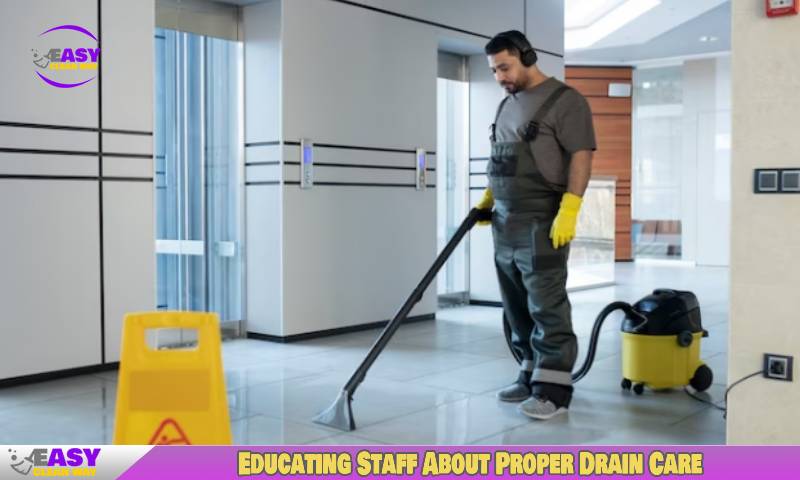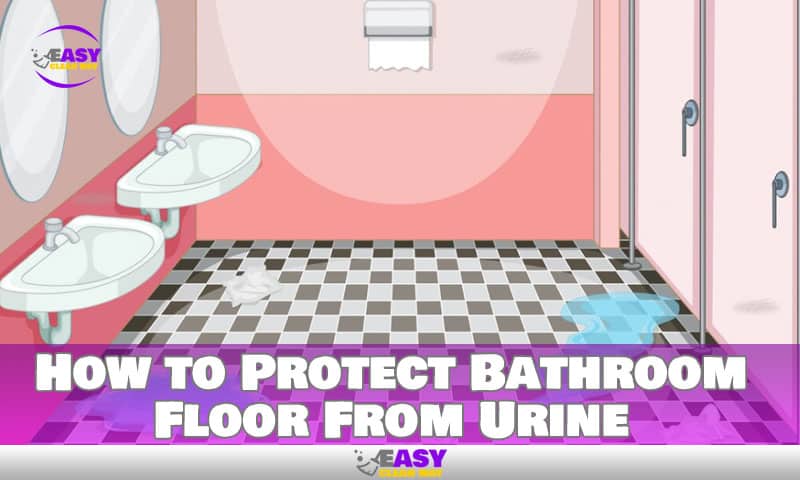
To clean restaurant floor drains, start by removing any debris or garbage, then scrub the floor drain with a brush and a mixture of hot water and cleaning solution. Next, rinse the drain with clean water and use a wet/dry vacuum to remove any excess moisture.
After that, sanitize the drain using a disinfectant solution, and finally, pour a small amount of cooking oil into the drain to prevent any odors from forming. Having a clean restaurant floor drain is crucial for the overall hygiene and functionality of a restaurant.
Neglecting to clean the floor drains regularly can lead to unpleasant odors, clogs, and even pest infestations. We will guide you through the step-by-step process of cleaning restaurant floor drains, ensuring a safe and clean environment for your establishment. By following these simple steps, you can maintain a healthy and efficient drainage system, minimizing the risk of any potential issues. So, let’s dive in and learn how to clean restaurant floor drains effectively.
Why Clean Floor Drains Are Essential For A Hygienic Restaurant
Proper restaurant hygiene is of utmost importance when it comes to ensuring the health and satisfaction of your customers. While it’s easy to focus on visible areas such as tables, countertops, and floors, one crucial component that often goes unnoticed is the floor drain.
Neglecting to clean these drains regularly can lead to foul odors and pest infestations, posing a serious threat to the cleanliness and reputation of your establishment. Let’s explore why clean floor drains are essential for a hygienic restaurant.
Preventing Foul Odors And Pest Infestations
Regular cleaning of floor drains prevents the build-up of food debris, grease, and other organic matter that can lead to foul odors. Here’s why it’s crucial:
- Food particles and liquid waste can accumulate in the drains over time, creating a breeding ground for bacteria and microbes that produce unpleasant odors.
- These odors can easily waft through your restaurant, causing discomfort for your customers and potentially tarnishing your reputation.
- By implementing a routine drain cleaning schedule, you can eliminate these foul odors, ensuring a pleasant dining experience for your patrons.
Cleaning floor drains also helps prevent pest infestations. Here’s why it matters:
- Pests such as flies, cockroaches, and rodents are attracted to food remnants that accumulate in neglected drains.
- These unwanted guests can spread diseases, contaminate food preparation areas, and risk health inspection violations.
- By keeping your floor drains clean and free from food residues, you can minimize the potential for pest infestations and maintain a hygienic environment for both customers and employees.
It’s important to note that regular floor drain cleaning should be part of your restaurant’s overall sanitation program. Here are some tips to follow:
- Schedule regular cleaning and maintenance to ensure that drains are free from clogs and blockages.
- Use appropriate cleaning agents and tools to remove grease, debris, and bacteria effectively.
- Train your staff on the importance of drain maintenance and establish protocols for ongoing cleanliness.
- Consider professional drain cleaning services to ensure a thorough and hygienic outcome.
Remember, a hygienic restaurant contributes not only to the overall customer experience but also to the well-being and safety of everyone involved. By prioritizing the cleanliness of your floor drains, you can prevent foul odors, deter pests, and maintain an inviting space for everyone to enjoy their meals.
So, don’t overlook this vital aspect of restaurant maintenance, and make it a regular part of your cleaning routine.
Identifying Common Issues With Restaurant Floor Drains

Cleaning restaurant floor drains is an essential task that ensures the hygiene and functionality of the drainage system. Over time, these drains can become clogged or slow in draining, leading to unpleasant odors, potential health hazards, and operational issues within the establishment.
Therefore, it is crucial to be aware of the common issues that can arise with restaurant floor drains. In this section, we will discuss two primary problems that often occur: clogging and slow drainage, and the build-up of grease and food debris.
Clogging And Slow Drainage
Clogging and slow drainage are frequent problems encountered with restaurant floor drains. Here are the key points to understand about these issues:
- Blockages in the drain pipes can occur for a variety of reasons, such as food particles, debris, or even foreign objects like utensils or packaging materials getting stuck in the drain.
- Over time, grease and oil from food preparation areas can accumulate in the drain pipes, leading to the formation of a hard, sticky residue. This residue traps other materials and causes clogs.
- Another common cause of clogging is the accumulation of sediment and minerals, such as calcium and magnesium, in the water supply. These deposits can gradually build up and restrict the flow of water in the drain pipes.
- Slow drainage often indicates a potential clog. It might result from the early stages of debris buildup or partial blockages. Ignoring slow drainage may result in a complete blockage later on.
- To prevent clogging and slow drainage, regular inspections and maintenance should be performed. This includes cleaning the drains, removing debris, and checking for any signs of potential blockages.
Build-Up Of Grease And Food Debris
Grease and food debris are major contributors to drain issues in restaurants. Here is what you need to know about this problem:
- During food preparation and dishwashing, grease and food particles tend to find their way into floor drains. Over time, this build-up can restrict water flow and cause clogs.
- Grease can solidify and cling to the inner surfaces of the drain pipes, narrowing the diameter and obstructing the water passage. The stickiness of the residue makes it an ideal trap for other particles, exacerbating the problem.
- Food particles, especially those high in starch or fiber, can create a sludge-like substance when mixed with grease. This thick mixture can accumulate in the drain pipes and hinder proper drainage.
- Regularly cleaning the drains with appropriate grease-trapping products and ensuring proper disposal of food waste are crucial steps in preventing the build-up of grease and food debris.
- Implementing kitchen practices that minimize the introduction of grease and food particles into the drains, such as using strainers and regular maintenance of grease traps, can significantly reduce the risk of clogs and slow drainage.
By understanding these common issues with restaurant floor drains, you can take proactive measures to prevent clogs, slow drainage, and other related problems. Regular cleaning, maintenance, and proper waste management practices are key to maintaining a functional and clean drainage system in your restaurant.
Best Practices For Regular Floor Drain Cleaning
Daily sweeping and mopping:
- Sweeping: Start by sweeping the restaurant floor thoroughly using a broom or a dust mop. This will help remove large debris and prevent it from clogging the drains.
- Mopping: After sweeping, mop the floor using a neutral cleaning solution or a mixture of water and mild detergent. Ensure that you cover the entire floor, paying extra attention to the areas around the drain. This will help remove grease, dirt, and any other residue that may have accumulated.
- Benefits: Daily sweeping and mopping prevent the accumulation of debris in the drains, reducing the risk of clogs and foul odors. It also helps maintain a clean and hygienic floor for your staff and customers.
Using drain covers and strainers:
- Drain covers: Install drain covers on your restaurant floor drains to catch solid debris, such as food particles, hair, and trash. These covers act as barriers, allowing only water to pass through and preventing clogs and blockages.
- Strainers: In addition to drain covers, consider using strainers in sink drains to catch smaller particles that may otherwise accumulate and cause clogs. Empty and clean the strainers regularly to maintain their effectiveness.
- Benefits: Drain covers and strainers are effective in preventing debris from entering the drains. By using them, you can minimize the risk of clogs, reduce maintenance needs, and ensure the proper functioning of your floor drains.
Implementing a maintenance schedule:
- Regular inspections: Schedule regular inspections of your floor drains to identify any signs of clogs, leaks, or other issues. This will allow you to address the problem promptly and prevent any further damage or inconvenience.
- Cleaning routine: Develop a cleaning routine specifically for your floor drains. This may include using a drain brush or pipe cleaner to remove any buildup or residue that may have accumulated over time. Follow the manufacturer’s instructions or consult with a professional for the best cleaning methods.
- Professional services: Consider hiring professional plumbers or drain cleaning services to perform periodic maintenance on your restaurant floor drains. They have the expertise and specialized tools to thoroughly clean and unclog drains, ensuring optimal performance.
- Benefits: Implementing a maintenance schedule helps you stay proactive in maintaining your floor drains’ cleanliness and functionality. Regular inspections and cleanings can prevent major issues, prolong the lifespan of your drains, and save you from costly repairs in the future.
Remember, regular cleaning and maintenance of your restaurant floor drains are crucial for maintaining a clean and hygienic environment, ensuring the smooth operation of your kitchen, and enhancing the overall customer experience. By following these best practices, you can minimize the risk of clogs, foul odors, and potential drainage issues, allowing your restaurant to thrive.
Gathering The Necessary Tools And Supplies
When it comes to cleaning restaurant floor drains, having the right tools and supplies is essential. Here are the key items you’ll need to effectively clean your drains:
Rubber Gloves
- Rubber gloves provide protection for your hands and help prevent the spread of bacteria.
- They should be worn at all times when working with drains to ensure your safety and hygiene.
Drain Brush
- A drain brush is a specialized tool designed to effectively clean the inside of drain pipes.
- It has bristles that can reach deep into the drains, removing any debris, grease, or grime buildup.
- Use the drain brush in conjunction with a cleaning solution to thoroughly clean the drain.
Pipe Snake/Auger
- A pipe snake, also known as an auger, is a flexible tool used to remove clogs from drain pipes.
- It is especially useful for stubborn blockages that cannot be cleared with a drain brush.
- The snake can be inserted into the drain pipe, and its rotating action helps break up and remove the clog.
Baking Soda
- Baking soda is a natural and eco-friendly cleaning agent that can effectively eliminate odors and break down grease buildup in restaurant floor drains.
- Sprinkle a generous amount of baking soda down the drain, followed by hot water, to create a fizzy reaction that helps clean the drain.
Vinegar Or Commercial Drain Cleaner
- Vinegar is another great natural cleaning agent that can be used to clean restaurant floor drains.
- Its acidic properties help dissolve grease and other organic materials that may be clogging the drain.
- Alternatively, you can use a commercial drain cleaner specifically formulated for restaurant drains.
- Follow the product instructions carefully when using a commercial drain cleaner.
By gathering these essential tools and supplies, you’ll be well-equipped to tackle the task of cleaning your restaurant floor drains effectively and efficiently. Remember to always prioritize safety by wearing rubber gloves and following proper cleaning procedures for the best results.
Preparing The Drain For Cleaning
Restaurant floor drains are an essential component of a clean and hygienic establishment. However, they can become clogged with debris and food particles over time, leading to unpleasant odors and potential sanitation issues. To maintain a healthy environment, it’s crucial to regularly clean and clear out the restaurant floor drains.
In this section, we will discuss the first step in this process: preparing the drain for cleaning.
Removing Drain Covers:
- Start by identifying the type of drain cover in your restaurant. It could be a screw-in cover or a rubber cover that requires prying. Knowing the type will help you choose the appropriate tools for the job.
- If the drain cover is screw-in, use a screwdriver to loosen and remove the screws. Place the screws in a safe location to avoid misplacing them.
- For rubber covers, insert a flathead screwdriver or a pry bar under the edge of the cover. Gently lift and pry it away from the drain.
- Some drain covers may require additional force to remove. In such cases, you can use a rubber mallet or a hammer with a piece of cloth to protect the cover from damage.
- Once the drain cover is loose, lift it out of the drain carefully. Place it aside for cleaning separately.
Clearing Visible Debris:
- Before proceeding with the actual cleaning process, remove any visible debris or food particles from the drain. This step reduces the chances of clogs and helps with thorough cleaning.
- Wear gloves to protect your hands, and use a small scoop or dustpan to clear out any solid waste. Dispose of the debris in a waste bag or bin designated for garbage.
- Inspect the drain walls and surrounding areas for any stuck or stubborn debris. You can use a stiff-bristled brush or an old toothbrush to scrub away the residue.
- Make sure to remove anything that might be obstructing the flow of water through the drain. This includes grease build-up, soap scum, and other residues.
- Place the collected debris in the garbage bag and seal it properly to avoid any unpleasant odors.
By following these steps, you will have successfully prepared the restaurant floor drain for the cleaning process. Removing the drain covers and clearing visible debris is an important initial step to ensure a thorough and effective cleaning. In the next section, we will delve into the actual process of cleaning the drain to maintain optimal cleanliness and functionality.
Basic Cleaning Techniques
Using Hot Water And Soap
One of the basic cleaning techniques for restaurant floor drains is to use hot water and soap. This simple method can effectively remove grease, grime, and food particles from the drain, keeping it clean and free from unpleasant odors. Here are key points to keep in mind:
- Fill a large container or bucket with hot water.
- Add a generous amount of dish soap or a degreaser to the water.
- Use a scoop or a large cup to pour the soapy water directly into the drain.
- Allow the hot water and soap mixture to sit in the drain for a few minutes to break down any stubborn debris.
- Then, use a long-handled brush or a stiff bristle brush to scrub the drain thoroughly.
- Scrub in a circular motion to ensure all areas of the drain are cleaned.
- Rinse the drain with hot water to remove the soap residue.
- Repeat the process if needed until the drain is clean and odor-free.
Using hot water and soap is a cost-effective and easy way to maintain the cleanliness of restaurant floor drains. It is important to perform this cleaning routine regularly to prevent clogs and keep the drains functioning properly.
Using A Drain Brush To Scrub The Drain
Another effective technique for cleaning restaurant floor drains is using a drain brush. This method allows for more targeted cleaning and can help remove stubborn debris and buildup. Here’s what you need to know:
- Purchase a drain brush with stiff bristles that can reach into the drain.
- Start by removing any visible debris or food particles from the drain using a gloved hand or a small scoop.
- Insert the drain brush into the drain and begin scrubbing the interior walls of the drain.
- Use firm strokes and apply pressure to dislodge any grease or buildup.
- Pay attention to the area around the edges and corners of the drain, as these areas are prone to accumulation.
- After scrubbing, rinse the drain with hot water to flush away the loosened debris.
- Repeat the process if necessary until the drain is thoroughly cleaned.
Using a drain brush is especially recommended for drains that have not been cleaned for a while or are showing signs of heavy buildup. Regular use of a drain brush can help maintain the integrity of the drain and prevent potential clogs.
Using A Pipe Snake To Remove Stubborn Clogs
For tougher clogs that cannot be removed using hot water and a brush, a pipe snake can come to the rescue. This tool is designed to navigate through the pipes and dislodge any obstructions. Follow these steps to effectively use a pipe snake:
- Purchase or rent a pipe snake suitable for the size of your drain.
- Insert the snake into the drain, pushing it in slowly and steadily.
- Rotate the snake clockwise to help it navigate through the twists and turns of the pipe.
- If you encounter resistance or feel the snake has reached the clog, apply gentle pressure and continue pushing.
- Once you have passed the clog or feel it loosening, slowly retract the snake, keeping a firm grip to avoid any splashing.
- Dispose of any debris or residues removed by the snake in a suitable container or garbage bag.
- After using the pipe snake, flush the drain with hot water to ensure the clog has been fully cleared.
Using a pipe snake may require some practice and caution, so it’s important to follow the manufacturer’s instructions and take the necessary safety measures. This method is especially useful for persistent clogs that cannot be resolved through other cleaning techniques.
By utilizing these basic cleaning techniques of using hot water and soap, using a drain brush, and using a pipe snake, you can effectively clean and maintain the restaurant floor drains. Regular cleaning of drains is crucial to preventing clogs, maintaining proper sanitation, and ensuring a pleasant dining experience for customers.
Deep Cleaning Methods For Stubborn Grease And Clogs
When it comes to maintaining a clean and hygienic restaurant, it is essential not to overlook the floor drains. Regular cleaning of these drains is necessary to prevent the buildup of grease, food particles, and other debris that can lead to unpleasant odors and even clogs.
While regular maintenance can keep most drains clean, there are times when a deeper clean is required to tackle stubborn grease and clogs. In this section, we will explore two effective methods for deep cleaning restaurant floor drains: using baking soda and vinegar and utilizing commercial drain cleaners.
Using Baking Soda And Vinegar
Baking soda and vinegar, when combined, create a powerful solution that can dissolve grease and remove stubborn clogs from restaurant floor drains. Here are the steps for using this natural cleaning method:
- Start by pouring half a cup of baking soda down the drain.
- Follow this by pouring half a cup of vinegar down the drain, causing a fizzing reaction.
- Allow the baking soda and vinegar mixture to sit in the drain for about 30 minutes.
- After 30 minutes have passed, flush the drain with hot water to clear away any remaining residue.
- This method is not only effective but also environmentally friendly, as it avoids the use of harsh chemicals that can be harmful to the environment and to the drain pipes themselves.
Utilizing Commercial Drain Cleaners
Commercial drain cleaners are another option for deep cleaning stubborn grease and clogs in restaurant floor drains. Here are the key points to keep in mind when using these cleaners:
- Before using a commercial drain cleaner, wear protective gloves and ensure good ventilation in the area.
- Read the instructions on the product carefully, as different drain cleaners may have varying application methods.
- Apply the drain cleaner according to the manufacturer’s instructions, making sure to cover the entire drain area.
- Allow the drain cleaner to work for the recommended amount of time, usually around 15-30 minutes.
- After the designated time has passed, flush the drain with hot water to remove any remaining residue.
- Remember to handle commercial drain cleaners with caution, as they can contain harsh chemicals that can be harmful if not used properly.
By following these deep cleaning methods, restaurant owners and staff can ensure that their floor drains remain clean, free of grease, and functioning properly. Regular maintenance combined with periodic deep cleaning will help prevent clogs and eliminate unpleasant odors, creating a hygienic environment for both employees and customers.
Implementing Regular Inspections And Cleaning Schedules
Designating Responsible Team Members
When it comes to keeping your restaurant floor drains clean, it’s important to designate responsible team members who will be in charge of inspections and cleaning. This ensures that the task is consistently carried out and that everyone understands their role in maintaining cleanliness and hygiene.
Here are some key points to consider when designating responsible team members:
- Assign specific individuals or teams to oversee the inspections and cleaning of restaurant floor drains.
- Provide proper training and guidance to these team members to ensure they understand the importance of their role and how to effectively clean the drains.
- Clearly communicate expectations and responsibilities to the designated team members to avoid any confusion.
- Foster a sense of accountability among the team by regularly checking in on their progress and providing feedback and support when necessary.
Frequency Of Inspections And Cleaning
Regular inspections and cleaning are essential for maintaining the cleanliness of restaurant floor drains. By implementing a consistent schedule, you can prevent any potential issues from arising and ensure the smooth functioning of your drains. Consider the following points when determining the frequency of inspections and cleaning:
- Conduct daily visual inspections to identify any visible debris or signs of clogging in the floor drains.
- Schedule thorough cleaning sessions at least once a week, depending on the level of usage and the nature of your restaurant’s operations.
- Adjust the frequency of inspections and cleanings as needed based on the volume of traffic, the type of food served, and any specific regulations or guidelines in your area.
- Keep a record of when inspections and cleanings occur to maintain a log of maintenance activities.
Cleaning restaurant floor drains is a crucial part of keeping your establishment clean and hygienic. By designating responsible team members and implementing regular inspections and cleaning schedules, you can ensure that your drains remain in optimal condition and prevent any potential problems from arising.
So, take the necessary steps to keep your restaurant floor drains clean and maintain a healthy environment for both your staff and customers.
Educating Staff About Proper Drain Care

Proper drain care is crucial for maintaining a clean and hygienic restaurant environment. Educating your staff on how to take care of the restaurant floor drains is essential to preventing issues such as blockages and unpleasant odors. By implementing effective training and fostering a culture of drain care awareness, you can ensure the longevity and functionality of your drain system.
Here are some key points to consider:
Training On Waste Disposal Practices
- Train your staff on the proper disposal of waste and food particles to prevent them from entering the floor drains.
- Emphasize the importance of scraping plates and trays into designated waste containers before rinsing them in sinks.
- Ensure that staff members are aware of the specific items that should not be disposed of down the drains, such as fats, oils, and grease (fog).
- Encourage the use of strainers or screens to prevent solid waste from entering the drains.
Importance Of Reporting Issues Promptly
- Stress the significance of reporting any drainage issues promptly to the designated maintenance personnel.
- Create an open communication channel for staff members to report any clogs, slow drainage, or foul odors they notice.
- Explain the potential consequences of not addressing drainage issues, such as health code violations, customer complaints, and the risk of damage to the drain system.
- Provide guidance on the appropriate steps to take when encountering drainage problems, ensuring that staff members are familiar with contacting maintenance or plumbing services.
By implementing training on waste disposal practices and emphasizing the importance of promptly reporting drainage issues, you can ensure that your staff understands the critical role they play in maintaining clean restaurant floor drains. Regularly reinforcing these practices will help minimize the occurrence of expensive repairs, prevent disruptions to daily operations, and ensure a pleasant dining experience for your customers.
Recap Of Essential Cleaning Steps And Maintenance Practices
Ensuring Hygienic Conditions For Employees And Customers
Maintaining a clean and hygienic environment is crucial for any restaurant. By ensuring the proper cleaning of floor drains, you can contribute to both the safety of your employees and the satisfaction of your customers. Here’s a recap of the essential cleaning steps and maintenance practices to keep your restaurant floor drains in top condition:
- Regular inspections: Conduct routine inspections of your floor drains to identify any signs of clogs, residues, or foul odors. A proactive approach will allow you to address any issues promptly before they become major problems.
- Clearing debris: Remove any visible debris, such as food particles, grease, and trash, from the drain cover. Use a brush or a scraper to dislodge and collect these materials, ensuring they don’t accumulate and cause blockages.
- Flushing with hot water: Flush the drain with hot water after clearing debris to eliminate any remaining residue. Hot water helps dissolve grease and other substances, preventing them from accumulating and causing blockages.
- Sanitizing with mild detergent: Use a mild detergent and warm water solution to sanitize the drain. Scrub the drain cover, surrounding surfaces, and the interior of the drain thoroughly to remove bacteria and prevent the buildup of unpleasant odors.
- Applying drain cleaner: Periodically use a suitable drain cleaner to prevent the accumulation of grease and organic matter. Follow the manufacturer’s instructions and ensure that the cleaner is food-safe and compatible with your drain system.
- Maintaining floor drain traps: Check the floor drain traps regularly and clean them as needed. Floor drain traps are designed to capture debris and prevent it from entering the sewer system. Cleaning them will help maintain their effectiveness.
- Monitoring the plumbing system: Keep an eye on your plumbing system to identify any signs of drainage issues or leaks. Promptly address any problems to prevent water damage and the growth of mold or mildew.
- Training employees: Educate your staff on the importance of proper drain maintenance and provide guidelines on how to clean floor drains correctly. Encourage them to report any issues they notice during their daily tasks.
- Scheduling professional maintenance: Consider hiring professional plumbers or drain cleaning services for periodic maintenance and inspections. Professionals can provide a deeper clean and offer expert advice on maintaining your floor drains.
- Documenting maintenance activities: Keep a record of all cleaning and maintenance activities performed on your restaurant floor drains. This documentation will help you track the frequency of cleaning, identify recurring issues, and demonstrate your commitment to maintaining hygienic conditions.
By adhering to these cleaning steps and maintenance practices, you can ensure the hygienic conditions your employees and customers deserve while extending the lifespan of your restaurant floor drains. A clean and well-maintained drainage system contributes to the overall cleanliness of your establishment and enhances the dining experience for everyone.
FAQ
How Often Should Restaurant Floor Drains Be Cleaned?
Restaurant floor drains should be cleaned at least once a month to prevent clogs and maintain a clean environment.
What Can Happen If Restaurant Floor Drains Are Not Cleaned Regularly?
If restaurant floor drains are not cleaned regularly, they can become clogged with debris, leading to unpleasant odors, water backups, and potential health code violations.
What Is The Best Method For Cleaning Restaurant Floor Drains?
The best method for cleaning restaurant floor drains is to remove the drain cover, scrub the drain pipe with a brush and hot soapy water, and then flush the drain with a mixture of hot water and vinegar to remove any remaining buildup.
Conclusion
Maintaining cleanliness in restaurant floor drains is crucial for the overall hygiene of the establishment. By regularly cleaning and maintaining these drains, you can prevent clogs, bad odors, and potential health hazards. Start by removing any debris or food particles manually, then use a mixture of hot water and disinfectant to flush out the drain pipes.
It is important to use proper safety equipment and follow the manufacturer’s instructions when using chemicals. Implementing a routine maintenance schedule will ensure that your restaurant floor drains remain clean and odor-free. Remember, a clean restaurant not only keeps your customers happy but also promotes a healthy work environment for your staff.
So, incorporate regular floor drain cleaning into your restaurant’s cleaning routine and enjoy the benefits of a clean and well-maintained establishment.
Hey there! I’m Wilfred Holguin, your Home Clean Expert blogger. I’m on a quest to help you conquer the clutter in your home and embrace the joys of a tidy home.




